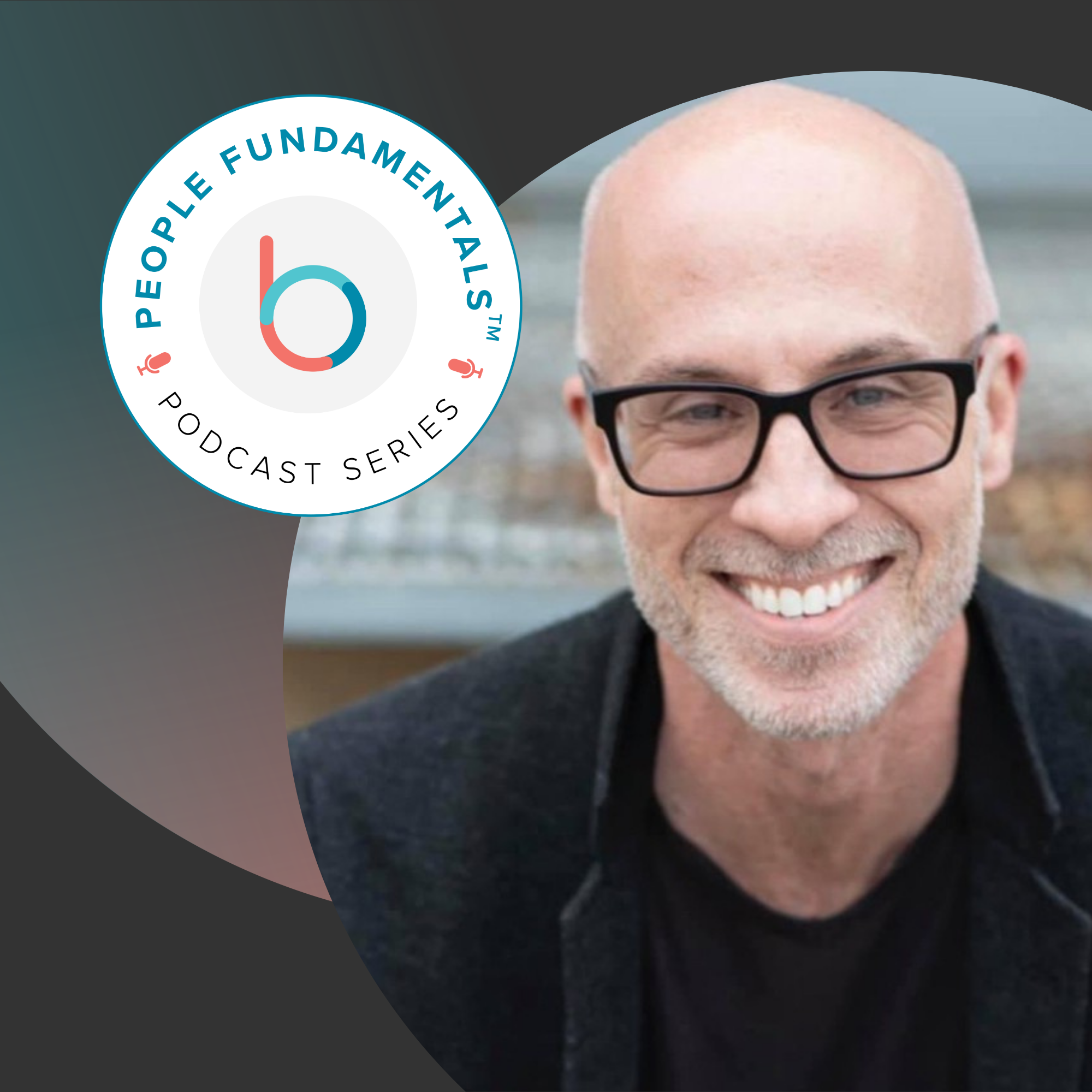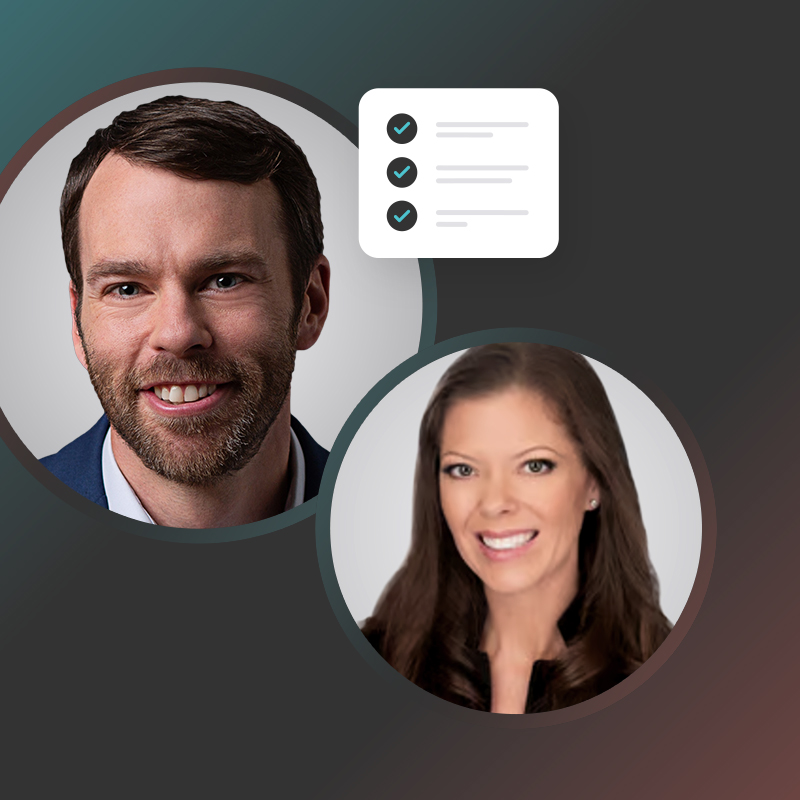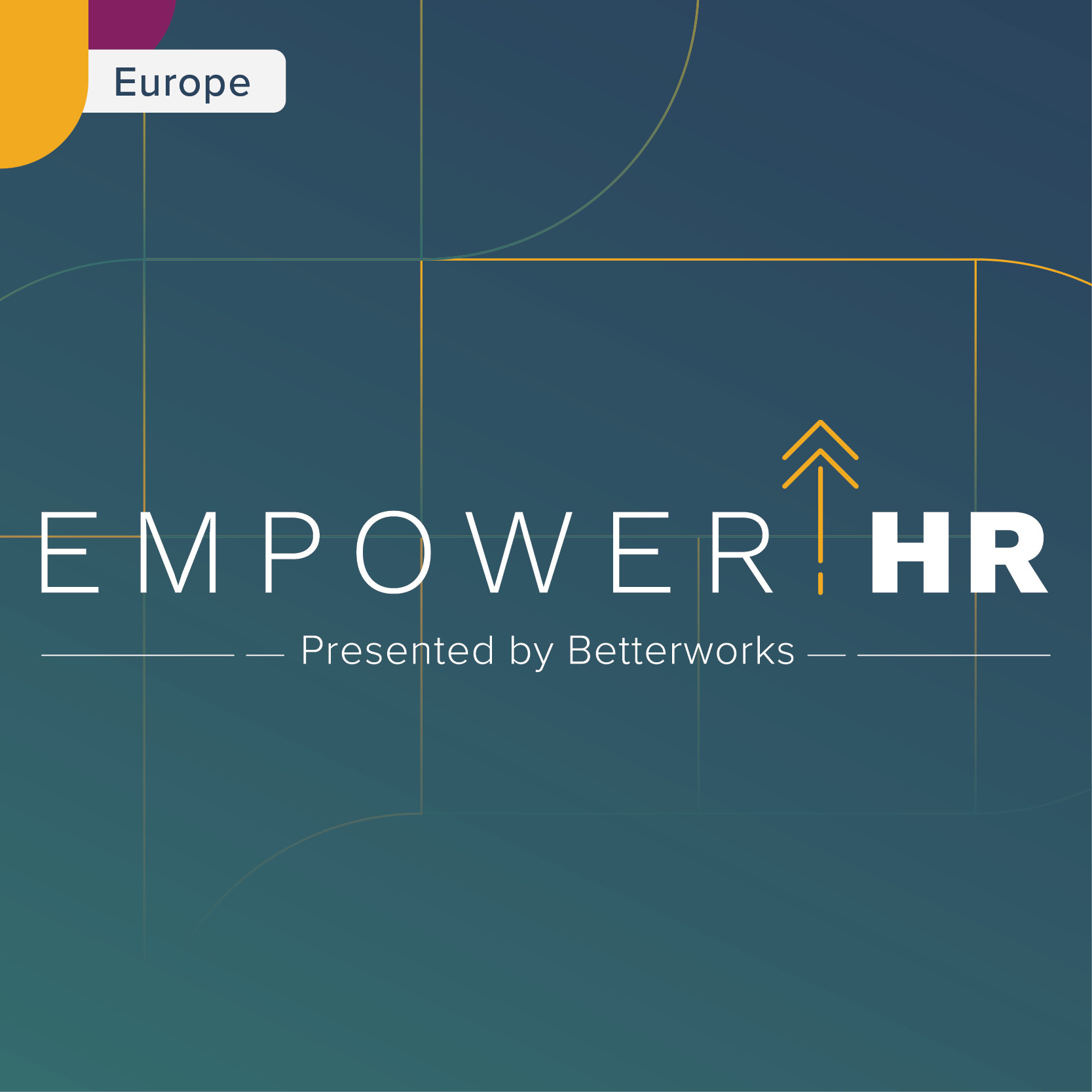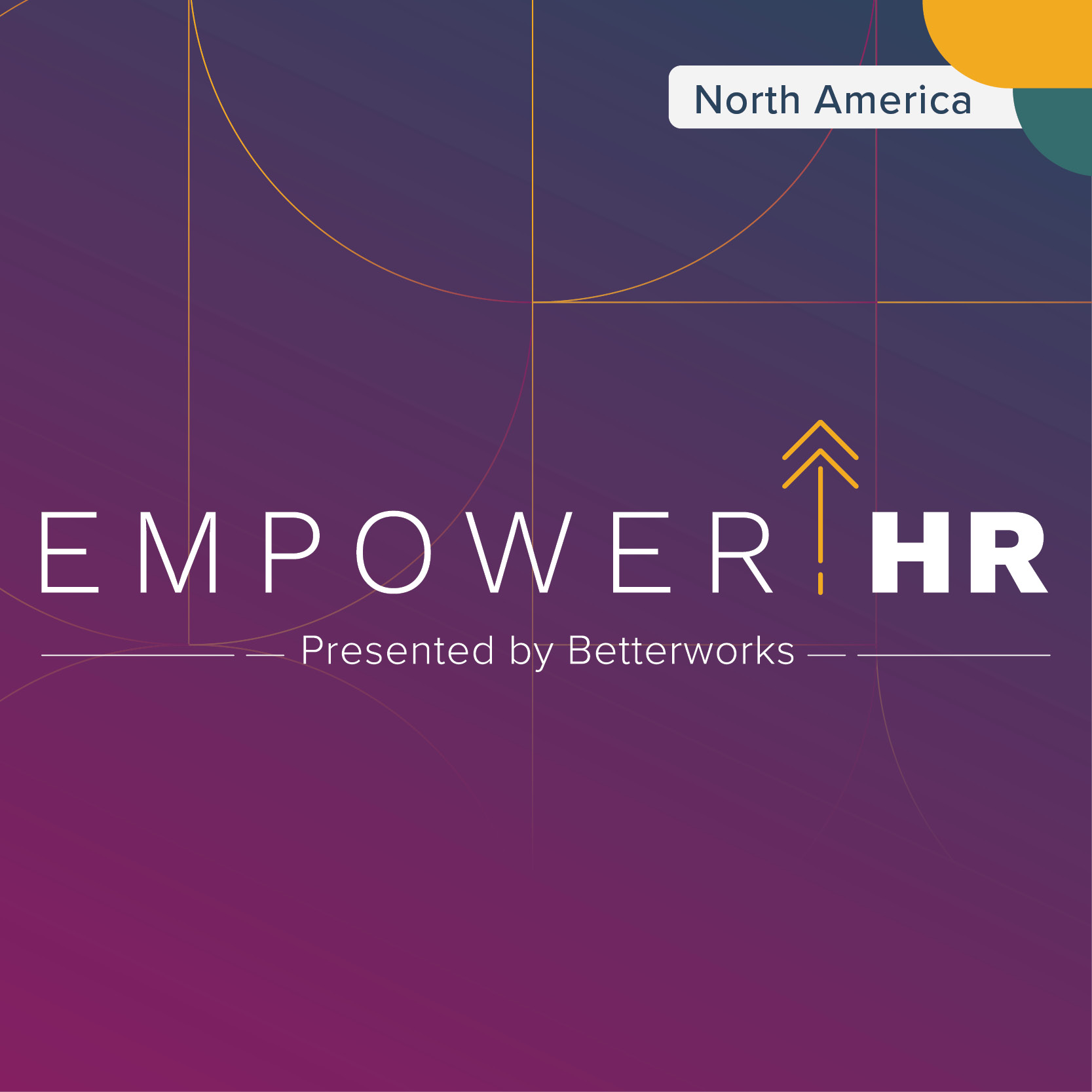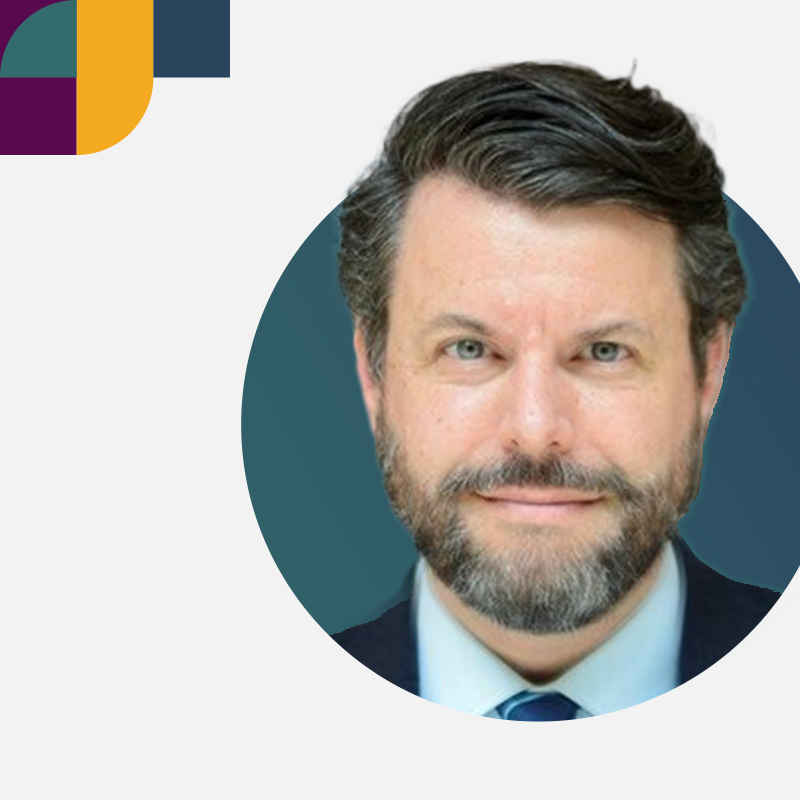- 10 HR challenges leaders are facing in 2025
- Integrating AI into work
- Transforming HR into a strategic business force
- Prioritizing the evolving employee experience
- Closing the skills gap to help workforces adapt
- Avoiding middle-manager burnout
- Effectively identifying and deploying internal talent
- Acquiring the right talent in a competitive market
- Resolving the RTO-hybrid battle
- Translating employee data for decision-making
- Deciding how to best simplify the HR tech stack
- Overcoming HR challenges in 2025 with Betterworks
Employers have faced endless human resource management challenges in recent years, and each year seems to bring more than the last. This year is no different, with the continuation of some HR challenges from last year and several new ones.
Let’s dive into the biggest challenges in HR management that Betterworks’ leadership team sees gaining prominence, and discover the opportunities that lie ahead for HR leaders in 2025.
10 HR challenges leaders are facing in 2025
Emerging HR trends in 2025 point toward a future defined by rapid technological advancements, evolving workforce priorities, and shifting global dynamics. The integration of AI will likely become more sophisticated, reshaping decision-making processes and skill development. Meanwhile, employee experience and flexible work environments remain central to business strategies.
Here are some of the trends and the associated HR challenges you can anticipate in 2025 and how to stay ahead of them.
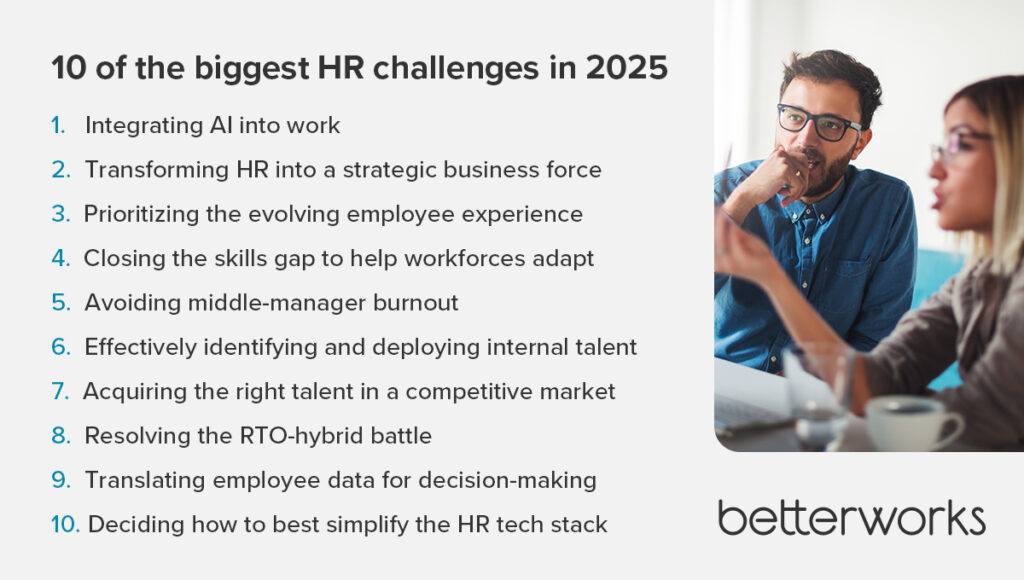
Integrating AI into work
In 2025, HR departments face the transformative challenge of integrating AI into daily workflows. AI technologies offer vast opportunities to improve efficiency, enhance performance management, equip managers to be more effective, and personalize the employee experience. Nearly half (42%) of business leaders surveyed by IBM at the beginning of the year had already actively deployed AI, and another 40% were in the process of doing so.
However, this rapid advancement raises concerns and requires thoughtful implementation by business leaders. “The rapid rise of AI technologies is reshaping the workforce, presenting both significant opportunities and complex challenges for HR leaders,” says Betterworks CEO Doug Dennerline. “Organizations must develop frameworks to enable effective human-AI collaboration while addressing concerns about job security and displacement.”
To meet this challenge, prioritize upskilling yourself and your team in AI fundamentals. “To lead the conversation on generative AI and the impact of algorithmic decision-making, HR must first upskill themselves in the technology’s fundamentals,” says Betterworks CMO John Schneider. “By leaning into the tools themselves, HR can separate fact from fiction amidst media noise, becoming the trusted voice that ensures AI enhances, rather than undermines, human potential in the workplace.”
By fostering transparency around AI adoption, engaging employees in open dialogue, and using AI to complement rather than replace human roles, you can drive innovation while maintaining trust. Use regular check-ins to gather feedback on AI implementations and to maintain alignment with organizational goals.
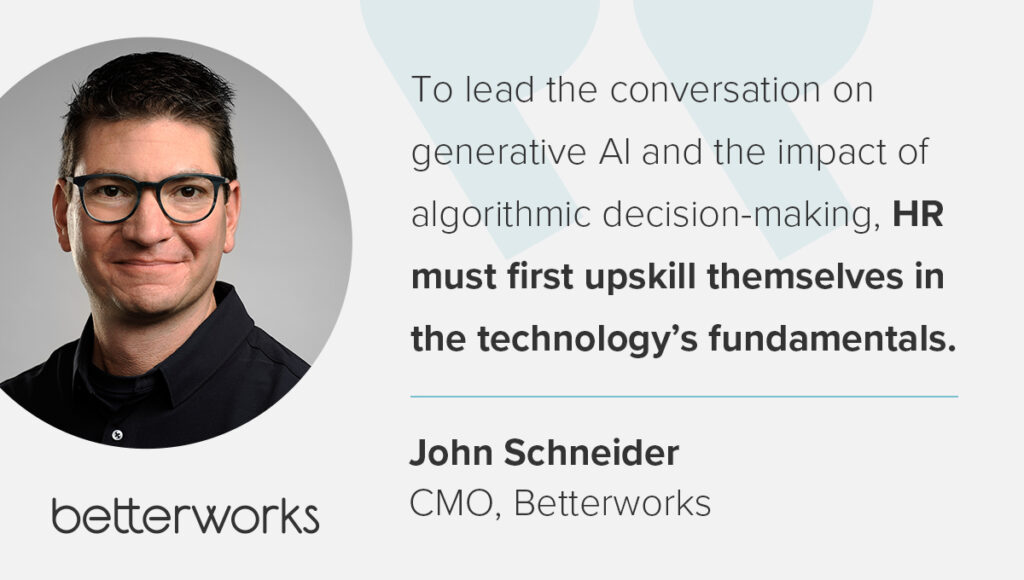
Transforming HR into a strategic business force
The role of human resource management has evolved dramatically. In 2025, HR leaders are expected to step up as strategic business partners. This shift is driven by the demand for measurable impact on business outcomes, whether through talent strategies, employee engagement, or workforce agility. The ability to shape the long-term success of an organization now rests on your ability to align human resource management initiatives with broader goals.
“HR is no longer about pushing paper or managing policies — it’s about stepping into the arena of strategic impact,” John says. “CEOs demand impact, not process, and HR has the unique opportunity to shape the workforce for what’s next, not just what’s now.”
To transform HR into a strategic force, leaders must harness the power of people analytics to inform decision-making, predict trends, and identify areas of opportunity. “As AI and automation reshape job roles, CHROs can champion workforce transformation by creating robust upskilling and reskilling initiatives that empower employees to thrive in evolving roles while fostering transparency and trust,” says Jamie Aitken, VP of HR transformation at Betterworks.
By aligning HR management strategies with business needs, you can foster resilience and adaptability, helping employees feel valued and equipped for the future.
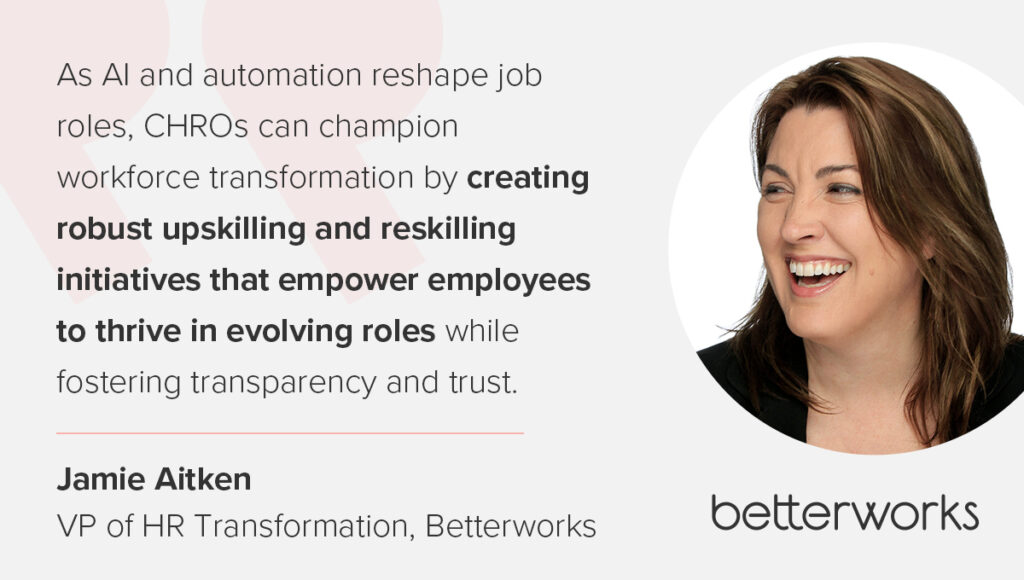
Prioritizing the evolving employee experience
This year, prioritizing the employee experience is critical for employee engagement and retention. As flexible work arrangements and remote work continue to shape workplace norms, you’ll experience increasing pressure to make sure that employees feel supported, connected, and motivated. A strategic focus on the moments that matter — such as onboarding processes, professional development, and work-life balance — can help change organizational culture to attract and retain top talent.
“By fostering innovation, resilience, and agility, HR’s strategic approach ensures a sustainable competitive advantage and positions the organization for long-term success,” Jamie says. “To be successful, many HR teams are leveraging design thinking principles to uncover ‘areas of opportunity’ in their processes and explore how they can reimagine the moments that matter for employees.”
By implementing regular check-ins, gathering feedback, and using performance management tools to align goals with employee aspirations, you can create a work environment that prioritizes both mental health and productivity. Flexible work policies, supported by technology that facilitates connection and collaboration, help remote and hybrid teams remain engaged. These efforts help employees feel valued and supported while driving organizational success.
Closing the skills gap to help workforces adapt
Upskilling and reskilling efforts are essential for keeping employees engaged, enhancing their contributions, and driving long-term success in 2025. “The rapid pace of digital transformation and AI adoption has revealed significant skills gaps,” says Betterworks COO Andrea Lagan. “HR leaders must prioritize upskilling and reskilling to future-proof their workforce.”
Yet, according to our 2024 Skills Fitness report, many business leaders struggle to pinpoint the most critical skills gaps in their workforces. Nearly 7 in 10 use performance evaluations for measuring skills and competencies, but a majority only do those assessments 1-2x per year, leading to a lack of useful data.
Embrace AI-powered tools, like Betterworks, to identify skills gaps, personalize training paths, and track progress in real time. Gamification, accessible training options, and ongoing feedback make learning engaging and dynamic while providing employees with clear development pathways. By integrating real-time tracking, you can make sure that upskilling efforts remain aligned with business needs.
Avoiding middle-manager burnout
Middle managers often find themselves overburdened as organizations streamline operations to improve efficiency. According to a Capterra survey of middle managers, 71% report sometimes or always feeling burned out, and 30% are actively looking for a new job. Without proper support, you risk losing your vital middle managers, which can trickle down to their direct reports and impact overall employee retention and engagement.
“Many organizations are seeking efficiencies by cutting back on middle management in an attempt to streamline decision-making and operations,” says Cheryl Johnson, chief product and technology officer at Betterworks. “While this can be an effective strategy, it also comes with challenges that, if not addressed, can lead to middle-management burnout and disaffection, which can spread to the teams they manage.”
To mitigate this, invest in continuous performance management tools. These provide managers with real-time insights and accommodate performance conversations in the flow of work.
Effectively identifying and deploying internal talent
Matching the right talent to the right roles remains a critical HR management issue, especially in large organizations. Traditional methods often lack the agility needed to address dynamic business needs, slowing progress and affecting morale.
“Matching talent to roles or projects is increasingly complex, especially in large organizations. Traditional talent management lacks the agility to meet dynamic business needs,” Andrea says. “AI transforms this process by rapidly evaluating performance, potential, and aspirations, enabling precise, real-time talent alignment. Tools like internal talent marketplaces and predictive succession planning further enhance agility and ensure readiness for future demands.”
Invest in AI tools to streamline talent alignment so employees feel valued and appropriately placed. By fostering transparency and providing growth opportunities, you can enhance employee retention and build a stronger, more adaptable workforce.
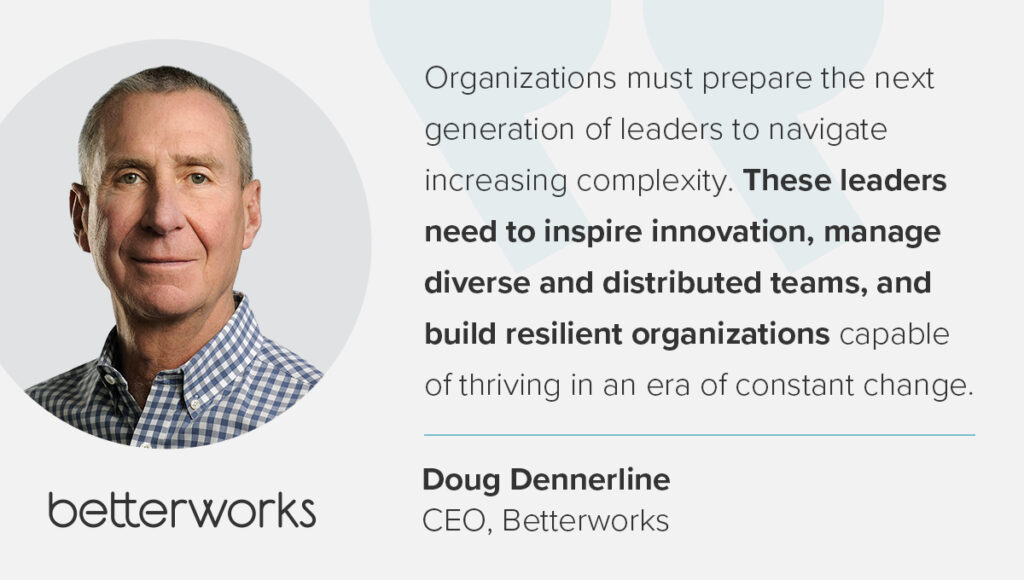
Acquiring the right talent in a competitive market
Competition for top talent has intensified in 2025, raising concerns about growth for 93% of executives, a study by Destination Workplace found.
HR leaders are obliged to navigate a competitive landscape shaped by a remote-first job market, rapid technological advancements, and shifting employee priorities. The skills gap continues to widen, leaving HR departments under pressure to not only attract but also develop the talent required to meet emerging demands. At the same time, candidates have greater expectations, and are seeking flexible work arrangements, purpose-driven roles, and clear opportunities for career growth.
Developing the right people to take on leadership roles poses another challenge. “Organizations must prepare the next generation of leaders to navigate increasing complexity, “Doug says. “These leaders need to inspire innovation, manage diverse and distributed teams, and build resilient organizations capable of thriving in an era of constant change. Successfully addressing these challenges requires a strategic, long-term approach to talent management rooted in adaptability, inclusivity, and alignment with future-focused business goals.”
Resolving the RTO-hybrid battle
As hybrid work and remote work remain popular among employees, tensions persist between leadership advocating for return-to-office (RTO) mandates and employees valuing flexibility. These HR management issues highlight the need for balancing organizational goals with employee satisfaction. HR leaders must balance flexibility with productivity, maintain company culture, and navigate growing resentment among teams with differing work arrangements
“Leadership sees in-person work as vital for innovation, mentorship, and collaboration, while employees often view RTO as disconnected from modern work realities,” Doug says. “Middle managers are caught in the crossfire, tasked with enforcing policies while trying to retain top talent.”
Mediate this divide by implementing hybrid work models that promote equity and collaboration. Effective hybrid work models require careful attention to fairness and accessibility. Ensuring equity between in-office and remote employees can help mitigate proximity bias and create a more inclusive work environment. Addressing these challenges with thoughtful policies and collaborative technology ensures that hybrid teams remain engaged and productive while feeling valued.
Translating employee data for decision-making
Despite having access to vast amounts of employee data, many HR professionals struggle to turn it into actionable insights. This limits their ability to optimize leadership development, strategic HR planning, and workforce management strategies.
“Advanced analytics platforms and AI-driven dashboards can transform data into meaningful insights,” Andrea says, “enabling leaders to proactively monitor engagement, performance, and retention risks and make informed decisions that drive adaptability and success.”
By adopting user-friendly people analytics tools, you can translate complex data into clear workforce trends and actionable strategies. Regularly sharing these insights with leadership teams fosters alignment and helps employees feel their needs are being addressed.
Deciding how to best simplify the HR tech stack
HR management teams are under pressure to streamline their tech stacks without sacrificing essential tools. With economic uncertainty persisting, making thoughtful decisions about technology investments is critical.
Simplifying the HR tech stack requires a strategic balance between cost-saving measures and retaining essential tools. Cutting the wrong tools could set your talent strategy back and create more HR issues than it solves. “Teams need to be very thoughtful about what they cut out and why,” Cheryl says. “Technology investments, if executed well, can be strategic differentiators that drive business impact.”
Evaluate tools based on their long-term value, focusing on solutions that simplify processes, support flexible work, and enhance employee engagement. A cautious yet strategic approach ensures that the tech stack aligns with both current and future organizational needs.
Overcoming HR challenges in 2025 with Betterworks
This year, take a strategic approach to overcoming HR challenges by leveraging tools that enable continuous improvement in how we work and support our people.
With Betterworks, you can address critical challenges like aligning employee goals with business objectives, fostering regular check-ins that drive meaningful conversations, and enabling skill development to close gaps, prepare teams for the future, and improve retention. By focusing on continuous performance management, Betterworks helps HR departments create a work environment where employees feel engaged, supported, and empowered to succeed.
As you refine your HR strategy, consider how Betterworks can help you build a workforce primed for long-term success. Together, we can reimagine performance management to unlock the full potential of your team members and drive sustainable business outcomes.
HR leaders: Be prepared for 2025


